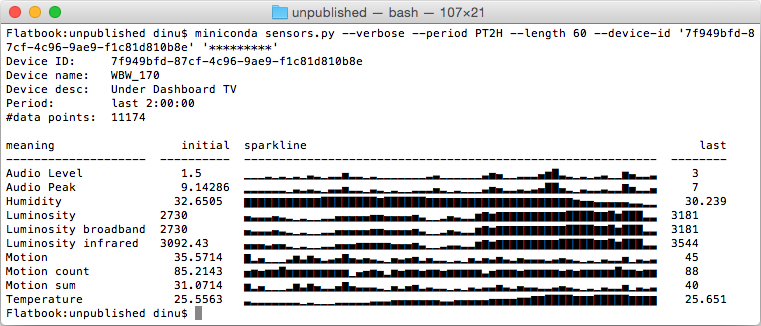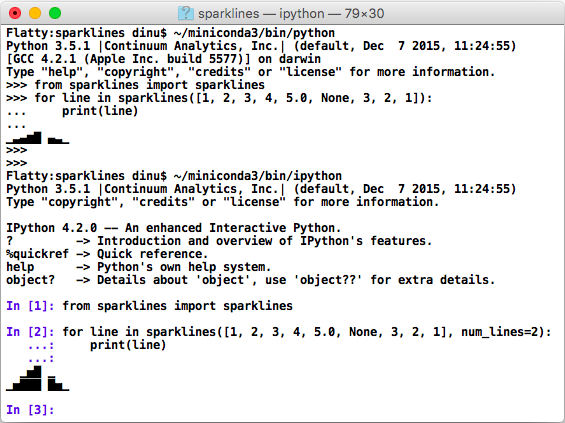






This Python package implements Edward Tufte's concept of sparklines, but limited to text only e.g. like this: ▃▁▄▁▅█▂▅ (this I likely not displayed correctly in every browser). You can find more information about sparklines on Wikipedia. This code was mainly developed for running simple plausibility tests in sensor networks as shown in fig. 1 below:

Fig. 1: Example usecase for such "sparklines" on the command-line, showing IoT sensor values (generating code not included here).
Due to limitations of available Unicode characters this works best when all values are positive. And even then true sparklines that look more like lines and less like bars are a real challenge, because they would need multiple characters with a single horizontal line on different vertical positions. This would work only with a dedicated font, which is way beyond the scope of this tool and which would significantly complicate its usage. So we stick to these characters: "▁▂▃▄▅▆▇█", and use a blank for missing values.
This code was tested ok at some point for Python 2.6 and 2.7, but no longer supports Python 2 after it reached end-of-life. Now Python 3.5 to 3.8 as well as PyPy 3 are all tested via Travis-CI.
This is a recorded sample session illustrating how to use sparklines (as
GitHub doesn't render embedded Asciinema recordings you'll see here an image
pointing to the respective
asciicast):

Here is some example output on the command-line (please note that in some browsers the vertical alignment of these block characters might be displayed slightly wrong, the same effect can be seen for other repos referenced below):
Examples for the code below:
$ sparklines 2 7 1 8 2 8 1 8
▂▇▁█▂█▁█
$ echo 2 7 1 8 2 8 1 8 | sparklines
▂▇▁█▂█▁█
$ sparklines < numbers.txt
▂▇▁█▂█▁█
$ sparklines 0 2. 1e0
▁█▅You can install this package using pip install sparklines from the Python
Package Index.
You can also clone this repository and install it via python setup.py install
or pip install -e ..
After installing, you will have access system-wide (or in your virtualenv
if you have used that) to sparklines, programmatically as well as via a
command-line tool with the same name.
To run the test suite, download and unpack this repository or clone it,
run pip inastall pytest, and run the command pytest tests in the
unpacked archive. from the downloaded repository's root folder.
Please note that the samples below might look a little funky (misaligned or even colored) in some browsers, but it should be totally fine when you print this in your terminal, Python or IPython session or your Python IDE of choice. Figure 2 below might show better what you should expect than the copied sample code thereafter:
Here are two sample invocations from the command-line, copied into this README:
$ sparklines 1 2 3 4 5.0 null 3 2 1
▁▃▅▆█ ▅▃▁
$ sparklines -n 2 1 2 3 4 5.0 null 3 2 1
▁▅█ ▁
▁▅███ █▅▁And here are sample invocations from interactive Python sessions, copied into
this README. The main function to use programmatically is
sparklines.sparklines():
In [1]: from sparklines import sparklines
In [2]: for line in sparklines([1, 2, 3, 4, 5.0, None, 3, 2, 1]):
...: print(line)
...:
▁▃▅▆█ ▅▃▁
In [3]: for line in sparklines([1, 2, 3, 4, 5.0, None, 3, 2, 1], num_lines=2):
print(line)
...:
▁▅█ ▁
▁▅███ █▅▁This code was inspired by Zach Holman's spark, converted to a Python module by Kenneth Reitz as spark.py and by RegKrieg to a Python package named pysparklines. And Roger Allen provides an even shorter spark.py.
But since it is so short and easy to code in Python we can add a few nice extra features I was missing, like:
- increasing resolution with multiple output lines per sparkline
- showing gaps in input numbers for missing data
- issuing warnings for negative values (allowed, but misleading)
- highlighting values exceeding some threshold with a different
color (if
termcolorpackage is available) - wrapping long sparklines at some max. length
- (todo) adding separator characters like
:at regular intervals
